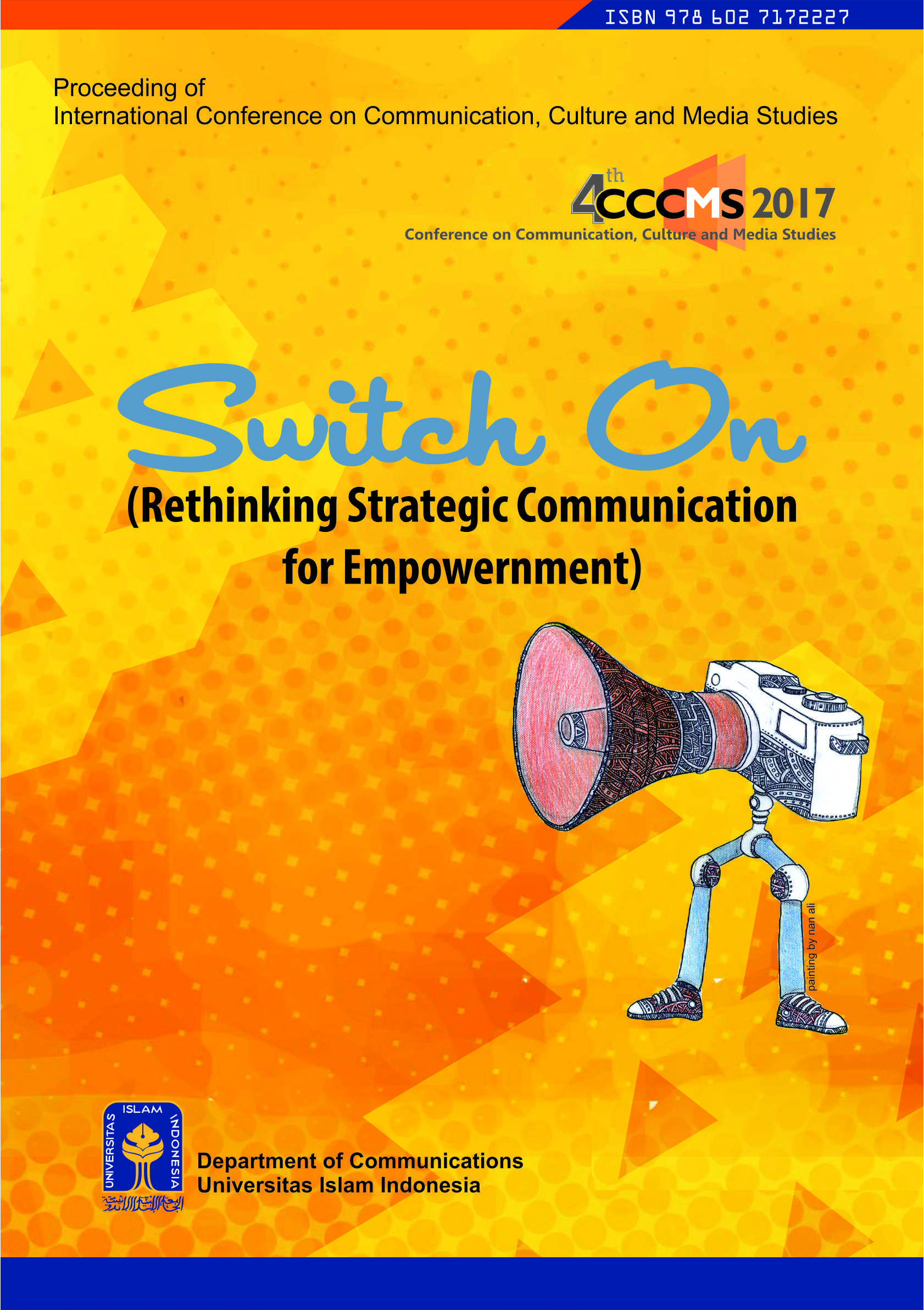Main Article Content
Abstract
E-dakwah (Electronic da’wah) is a term used to describe a preach that is publicly shared using the electronic media platform. In this study, the term E-da’wah refers to a message shared in social media, especially facebook fanpage. This study investigated the construction of da’wah message used by Ustadz in his facebook fanpage using the Pan and Kosicki’s framing analysis. In addition, in-depth-interview was also applied to collect data. The findings show that most da’wah message shared in facebook fanpage was constructed carefully to trigger discussions, critical thinking and also increase faith of the followers.
Keywords : E-dakwah; facebook fanpage; social media; religious activity; Ustadz
Article Details
References
- An, Seon-Kyoung and Karla K. Gower. (2009). How do the media frame crisis? A content analysis of crisis news coverage. Public Relations Review 35: 107–112. doi:10.1016/j.pubrev.2009.01.010
- Asia Marketing Research, Internet Usage, Population Statistics and Facebook Information. 2017. Retrieved from http://www.internetworldstats.com/asia.htm#id in August 11, 2017
- Baesler, E. J., & Chen, Y.-F. (2013). Mapping the Landscape of Digital Petitionary Prayer as Spiritual/Social Support in Mobile, Facebook, and E-mail. Journal of Media and Religion, 12(1), 1–15. http://doi.org/10.1080/15348423.2013.760385
- Campbell, Heidi A. (2011). Understanding the Relationship between Religion Online and Offline in a Networked Society. Journal of the American Academy of Religion, March 2012, Vol. 80, No. 1, pp. 64–93 doi:10.1093/jaarel/lfr074
- Cheong, P. H., Halavais, A., & Kwon, K. (2008). The Chronicles of Me: Understanding Blogging as a Religious Practice. Journal of Media and Religion, 7(3), 107–131. http://doi.org/10.1080/15348420802223015
- Daymon, Christine and Immy Holloway. (2005). Qualitative Research Methods in Public Relations and Marketing Communication. Routledge: London.
- Entman, Robert. (1993). Framing: Toward Clarification of a Fractured Paradigm. Journal of Communication 43(4), Autumn, 51-58.
- Hjarvard, Stig. (2008). The mediatization of religion a theory of the media as agents of religious change. Northern Lights, Intellect Ltd. Volume 6: 9-26. doi: 10.1386/nl.6.1.9/1
- ____________.(2011). The mediatisation of religion: Theorising religion, media and social change. Culture and Religion, Routledge, Vol. 12, No. 2, June 2011, 119–135 doi: 10.1080/14755610.2011.579719
- M. Faisal Ashaari, & N. Adhwa Farahin. (2012). Kriteria Newsworthiness dalam Entri Facebook Dakwah. Islamiyyat, 34, 45–51.
- Neuman, Lawrence W. (2003). Social Research Methods Qualitative and Quantitatives Approaches. Pearson Education, Inc. Our Mission. (2017). Retrieved from https://newsroom.fb.com/company-info/
- Products. (2017). Retrieved from https://newsroom.fb.com/company-info/
- Pan, Zhongdang and Gerald M. Kosicki. (1993). Framing Analysis: An Approach to news discourse, Political Communication: 10:1, 55-75. http://dx.doi.org/10.1080/10584609.1993.9962963
- Scheufele, A. Dietram.(1999). Framing as a Theory of Media Effects. Journal of Communication: 103-122; International Communication Association
References
An, Seon-Kyoung and Karla K. Gower. (2009). How do the media frame crisis? A content analysis of crisis news coverage. Public Relations Review 35: 107–112. doi:10.1016/j.pubrev.2009.01.010
Asia Marketing Research, Internet Usage, Population Statistics and Facebook Information. 2017. Retrieved from http://www.internetworldstats.com/asia.htm#id in August 11, 2017
Baesler, E. J., & Chen, Y.-F. (2013). Mapping the Landscape of Digital Petitionary Prayer as Spiritual/Social Support in Mobile, Facebook, and E-mail. Journal of Media and Religion, 12(1), 1–15. http://doi.org/10.1080/15348423.2013.760385
Campbell, Heidi A. (2011). Understanding the Relationship between Religion Online and Offline in a Networked Society. Journal of the American Academy of Religion, March 2012, Vol. 80, No. 1, pp. 64–93 doi:10.1093/jaarel/lfr074
Cheong, P. H., Halavais, A., & Kwon, K. (2008). The Chronicles of Me: Understanding Blogging as a Religious Practice. Journal of Media and Religion, 7(3), 107–131. http://doi.org/10.1080/15348420802223015
Daymon, Christine and Immy Holloway. (2005). Qualitative Research Methods in Public Relations and Marketing Communication. Routledge: London.
Entman, Robert. (1993). Framing: Toward Clarification of a Fractured Paradigm. Journal of Communication 43(4), Autumn, 51-58.
Hjarvard, Stig. (2008). The mediatization of religion a theory of the media as agents of religious change. Northern Lights, Intellect Ltd. Volume 6: 9-26. doi: 10.1386/nl.6.1.9/1
____________.(2011). The mediatisation of religion: Theorising religion, media and social change. Culture and Religion, Routledge, Vol. 12, No. 2, June 2011, 119–135 doi: 10.1080/14755610.2011.579719
M. Faisal Ashaari, & N. Adhwa Farahin. (2012). Kriteria Newsworthiness dalam Entri Facebook Dakwah. Islamiyyat, 34, 45–51.
Neuman, Lawrence W. (2003). Social Research Methods Qualitative and Quantitatives Approaches. Pearson Education, Inc. Our Mission. (2017). Retrieved from https://newsroom.fb.com/company-info/
Products. (2017). Retrieved from https://newsroom.fb.com/company-info/
Pan, Zhongdang and Gerald M. Kosicki. (1993). Framing Analysis: An Approach to news discourse, Political Communication: 10:1, 55-75. http://dx.doi.org/10.1080/10584609.1993.9962963
Scheufele, A. Dietram.(1999). Framing as a Theory of Media Effects. Journal of Communication: 103-122; International Communication Association
